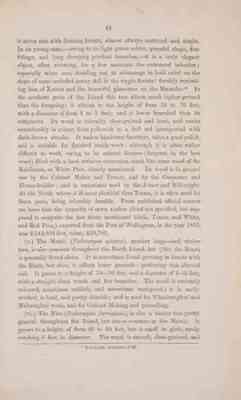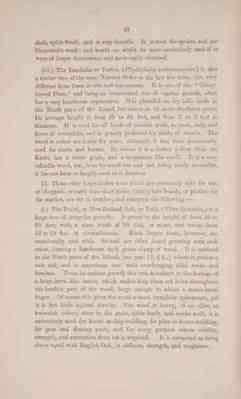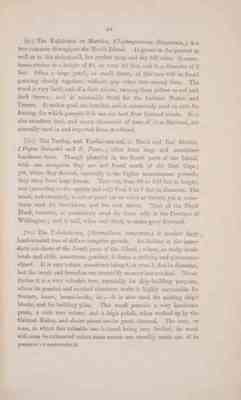Pages
41 situations. It splits well, and makes excellent shingles for roofs; and is very extensively used for posts in fencing. The heavier articles of furniture are sometimes made of it; and the portion of its wood which grows under a "knot" (or large warty excrescence, often seen on its trunk,) is peculiarly veined, owing to it grain there being very tortuous, and when polished highly beautiful. Those "knots" are eagerly sought after for veneering purposes in England, but the supply hitherto has been very scanty. (Vide § iv. sequente.)
(iii.) The Kahikatea, or White, or Swamp, Pine, (Podocarpus dacrydioides,) is the next commonly used timber tree. It is the most generally diffused throughout the North Island of all the timber trees, often forming large forests; and is almost invariably found in wet spots and swampy situations, and often on the low banks of rivers, at a much lower elevation than its congeners. It often grows to the height of 100 feet, and as its trunk is generally clear from living branches, it presents a tolerably clean barrel of from 50 to 70 feet. Its trunk, however, is frequently not so regularly formed as those of the other Podocarpi and the Kauri, being sometimes largely ribbed or buttressed for some distance upwards from its base. This tree is anything but handsome when growing in the forest; often, however, a single tree is met with standing alone and forming a very beautiful object. The timber of this tree has been, and is, pretty extensively used for all common purposes, apart from exposure or wet. It is the most easily obtained of all the New Zealand timbers; but, owing to its tendence to rot when exposed, and to its scarcely ever seasoning, (continually contracting and expand ing with the state of the weather,) it is only used when others are not to be had, For in-door work, however, it is often advantageously used. It is straight-grained, and where free from knots works easily. It has been used for spars for small vessels; and is sometimes split for fencerails, and for roof shingles. It is often found having fissures in the wood, filled with a hard dry adhesive gum-resin, which is difficult to cut or remove. It is said, that trees which have grown on a slope, or on gravelly land, possess closer-grained and more durable timber, than those of the low wet lands. Choice parts of the wood of this tree, from its light yellow colour, and rich changeable sparkling grain, are sometimes advantageously used as a contrast wood by the Cabinet Maker, to set off the darker coloured woods.
(iv.) The Rimu, or Red Pine, (Dacrydium cupressinum,) another large size timber tree, is also common throughout the North Island; but
42 is never met with forming forests, almost always scattered and single. In its young state, - owing to its light green colour, graceful shape, fine foliage, and long drooping pendent branches, - it is a truly elegant object, often rivetting, for a few moments the entranced beholder; especially when seen standing out to advantage in bold relief on the slope of some secluded sunny dell in the virgin forests! forcibly reminding him of Xerxes and the beautiful plane-tree on the Maeander.* In the northern parts of the Island this tree affects much higher ground than the foregoing; it attains to the height of from 50 to 70 feet, with a diameter of from 4 to 5 feet; and is lower branched than its congeners. Its wood is tolerably close-grained and hard, and varies considerably in colour, from yellowish to a dull red interspersed with dark-brown streaks. It makes handsome furniture, takes a good polish, and is suitable for finished inside work; although it is often rather difficult to work, owing to its natural fissures (frequent in the best wood) filled with a hard resinous concretion much like some wood of the Kahikatea, or White Pine, already mentioned. Its wood is in general use by the Cabinet Maker and Turner, and by the Carpenter and House-builder; and is sometimes used by the Joiner and Millwright. At the North, where it is more plentiful than Totara, it is often used for fence posts, being tolerably durable. From published official sources we learn that the quantity of sawn timber (kind not specified, but supposed to comprise the the last three mentioned kinds, Totara, and White, and Red Pine,) exported from the Port of Wellington, in the year 1863, was 2,143,303 feet, value, £19,705.
(v.) The Mataii (Podocarpus spicata), another large-sized timber tree is also common throughout the North Island, but (like the Rimu) is generally found alone. It is sometimes found growing in forests with the Rimu, but often it affects lower grounds; preferring rich alluvial soil. It grows to a height of 70-90 feet, and a diameter of 4-5 feet, with a straight clean trunk and few branches. The wood is variously coloured, sometimes reddish, and sometimes variegated; it is easily worked, is hard, and pretty durable; and is used for Wheelwrights' and Millwrights' work, and for Cabinet Making and pannelling.
(vi.) The Miro (Podocarpus ferruginea), is also a timber tree pretty general throughout the Island, but not so common as the Mataii. It grows to a height of from 40 to 60 feet, but is small in girth, rarely reaching 3 feet in diameter. The wood is smooth, close grained, and __________________________________________________________ * Herodotus, Polymnia, § 31.
43 dark, splits freely, and is very durable. It is used for spokes, and for Carpenter's work; and would no doubt be more extensively used if it were of larger dimensions, and more easily obtained.
(vii.) The Tanekaha or Toatoa, (Phyllocladus trichomanoides,) is also a timber tree of the same Natural Order as the last five trees, but very different from them in size and appearance. It is one of the "Celeryleaved Pines," and being an ornamental tree of regular growth, often has a very handsome appearance. It is plentiful on dry hilly lands in the North parts of the Island, but scarce in its more Southern parts. Its average height is from 45 to 50 feet, and from 2 to 3 feet in diameter. It is used for all kinds of outside work, as posts, rails, and floors of verandahs, and is greatly preferred for decks of vessels. The wood is rather too heavy for spars, although it has been occasionally used for masts and booms. In colour it is a darker yellow than the Kauri, has a closer grain, and a turpentine like smell. It is a very valuable wood, but from its small size and not being easily accessible, it has not been so largely used as it deserves.
25. Those other large timber trees which are commonly split for use, or chopped, or sawn into short junks, (rarely into boards, or planks) for the market, are six in number, and comprise the following:-
(i.) The Puriri, or New Zealand Oak, or Teak, (Vitex littoralis,) is a large tree of irregular growth. It grows to the height of from 50 to 60 feet with a clear trunk of 20 feet, or more, and varies from 12 to 25 feet in circumference. Much larger trees, however, are occasionally met with. Several are often found growing near each other, forming a handsome dark green clump of wood. It is confined to the North parts of the Island, (see par. 13, § ii.,) where it prefers a rich soil, and is sometimes met with overhanging tidal rocks and beaches. From its earliest growth this tree is subject to the borings of a large larva like insect, which makes long clean cut holes throughout the hardest part of the wood, large enough to admit a man's small finger. Of course this gives the wood a most unsighly appearance, yet it is but little injured thereby. The wood is heavy, of an olive, or brownish colour, close in the grain, splits freely, and works well; it is extensively used for knees in ship-building, for piles in house-building, for gate and fencing posts, and for every purpose where solidity, strength, and exemption from rot is required. It is estimated as being about equal with English Oak, in stiffness, strength, and toughness.
44 (ii.) The Kahikatoa or Manuka, (Leptospermum Scoparium,) is a tree common throughout the North Island. It grows in the poorest as well as in the richest soil, but prefers steep and dry hill sides. It sometimes attains to a height of 40, or even 45 feet, and to a diameter of 2 feet. Often a large patch, or small forest, of this tree willl be found growing closely together, without any other tree among them. The wood is very hard, and of a dark colour, varying from yellow to red and dark brown; and is admirably fitted for the Cabinet Maker and Turner. It makes good axe handles, and is extensively used as rails for fencing, for which purpose it is one our best New Zealad woods. It is also excellent fuel, and many thousands of tons of it as firewood, are annually used in and exported from Auckland.
(iii.). The Tawhai, and Tawhai-rau-nui, or Black and Red Birches, (Fagus Solandri and F. Fusca,) often form large and sometimes handsome trees. Though plentiful in the South parts of the Island, with one exception they are not found north of the East Cape; yet, where they flourish, especially in the higher mountainous grounds, they often form large forests. They run from 80 to 100 feet in height, and (according to the species and soil) from 3 to 7 feet in diameter. The wood, unfortunately, is not of great use or value as timber, yet is sometimes used for boat-knees, and for cask staves. That of the Black Birch, however, is extensively used for fence rails in the Province of Wellington; and is said, when well dried, to make good firewood.
(iv.) The Pohutukawa, (Metrosideros tomentosa,) is another large hard-wooded tree of diffuse irregular growth. Its habitat is the immediate sea-shore of the North parts of the Island; where, on the rocky headlands and cliffs, sometimes pendent, it forms a striking and picturesque object. It is very robust, sometimes being 4, or even 5, feet in diameter, but the trunk and branches are invariably more or less crooked. Nevertheless it is a very valuable tree, especially for ship-building purposes, where its gnarled and crooked character make it highly serviceable for timbers, knees, breast-hooks, &c., - it is also used for making ship's blocks, and for building piles. This wood presents a very handsome grain, a rich rose colour, and a high polish, when worked up by the Cabinet Maker, and choice pieces are in great demand. The area, or zone, in which this valuable tree is found being very limited, its wood will soon be exhausted unless some means are speedily made use of to preserve or economise it.
45 (v.) The Rata, (Metrosideros robusta,) a tree very closely allied generically to the Pohutukawa, is one of the largest of the New Zealand forest trees, often attaining a height of 120 feet, of which from 60 to 80 feet forms its trunk; which is sometimes very bulky, - one having been measured which was 54 feet in girth. Unlike the preceding, however, it is mostly found inland, at a tolerably high elevation, and is pretty general throughout the Island. Its growth is both regular and irregular, mainly arising from situation and soil. Its wood is heavy, red, close-grained, and durable; and is very valuable to the Wheelwright and to the Ship-builder, on account if its strength and toughness, owing to the peculiar twisting of its fibres; the roots and branches as well as the trunk affording excellent materials for naves, timbers, and knees. It is also a handsome wood for the purpose of the Cabinet Maker; and will answer well for all uses where Oak and Beech are required.
(vi.) The Aka, (Metrosideros scandens,) although (in bulk) a small tree, or climber, may also here be noticed; as it not only belongs to the same genus with the two preceding, and to the same sub-section, but is also very closely allied to them in its qualities and uses. This plant is generally common in all woods, and may be known as a large stout climber ascending to the tops of the highest trees, and often hanging like loose ropes from them. Like the others of the genus already noticed, it is heavy, close- grained, and tough, and is principally used for timbers for boats.
26. The trees which follow, though many are small and scarcely timber trees, comprise some which are useful to the Manufacturer. -
(i.) The Kowhai, or New Zealand Acacia, (Sophora, or Edwardisia, grandiflora,) is a small tree sometimes reaching to the height of 30 or 35 feet. Its wood is hard, and of two or three colours or varieties, varying from a bright yellow, in some specimens, to that of a light olive, or a dull Indian pink, in others. It is well fitted for the purposes of the Cabinet Maker and the Millwright.
(ii.) The Hinau, (Elaeocarpus dentatus,) a tree generally common in the drier woods in the interior, attains to the height of from 50 to 60 feet, and 3 feet, or upwards, in diameter. The wood, in general, of this tree is inferior, but the crooked parts of the wood, with the knots and warty excrescences, have a very beautiful marbled grain, and are therefore valuable to the Cabinet Maker.




